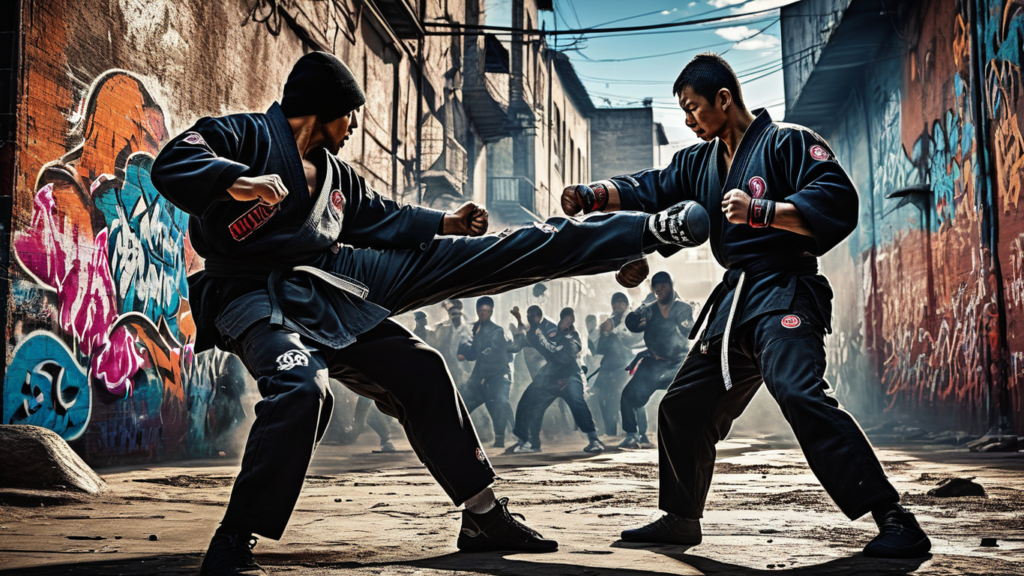
Introduction
- What are street fighting techniques?
- Importance of self-defense skills
Basic Principles of Street Fighting
- Understanding situational awareness
- Mental preparedness and confidence
Essential Techniques
- Striking techniques (H3: Punches, H3: Kicks)
- Defensive maneuvers (H3: Blocks, H3: Evasion)
Improvised Weapons
- Using common objects for defense (H3: Keys, H3: Bag)
Strategies for Street Encounters
- De-escalation tactics (H3: Verbal communication)
- Assessing escape routes (H3: Environment awareness)
Psychological Tactics
- Intimidation and assertiveness
- Mindset of a defender (H3: Staying calm under pressure)
Training and Conditioning
- Physical fitness for effective defense (H3: Cardiovascular exercises)
- Martial arts and self-defense classes (H3: Krav Maga, H3: Brazilian Jiu-Jitsu)
H2: Legal and Ethical Considerations
- Use of force laws
- Ethical implications of self-defense
H1: Real-Life Applications
- Case studies of successful defense (H3: Personal anecdotes)
- Analysis of common street attack scenarios (H3: Nighttime encounters, H3: Confined spaces)
Conclusion
- Recap of key points
- Importance of continuous training and preparedness
FAQs
- What should I do if someone tries to rob me on the street?
- Are street fighting techniques legal to use in self-defense?
- How can I improve my reaction time during an attack?
- Is it advisable to carry a weapon for self-defense?
- Can anyone learn street fighting techniques, regardless of age or physical condition?
Street Fighting Techniques
Introduction
In today’s unpredictable world, having a grasp of effective street fighting techniques isn’t just about physical prowess; it’s about being prepared to protect yourself in unexpected situations. Whether you’re a seasoned martial artist or someone looking to enhance their personal safety skills, mastering these techniques can make a crucial difference.
Basic Principles of Street Fighting
Understanding the fundamentals is paramount. Street fighting isn’t about complex moves but rather practical strategies that can be deployed quickly and decisively. It starts with cultivating situational awareness—knowing your surroundings and potential threats. Mental preparedness plays a crucial role too; confidence can deter potential attackers.
Essential Techniques
When it comes to physical techniques, simplicity and efficiency are key. Effective striking techniques like punches and kicks are vital. Punches should be aimed at vulnerable areas such as the nose or throat, while kicks can create distance or disable an assailant. Defensive maneuvers such as blocks and evasions are equally important to avoid incoming attacks.
Improvised Weapons
In dire situations, everyday objects can become tools for self-defense. Items like keys or a bag can be used to distract or fend off attackers, providing a crucial advantage in unexpected confrontations.
Strategies for Street Encounters
Preventing physical altercations is often the best defense strategy. Verbal de-escalation techniques can defuse tense situations before they escalate. Always assess escape routes and potential barriers in your environment to plan a safe exit strategy.
Psychological Tactics
Confidence and assertiveness can deter potential attackers. Projecting strength and being mentally prepared to defend yourself are invaluable assets in a street confrontation. Maintaining composure under pressure can also influence the outcome of a tense situation.
Training and Conditioning
Physical fitness directly correlates with effective self-defense. Cardiovascular exercises improve stamina, while martial arts and self-defense classes teach practical techniques (such as Krav Maga or Brazilian Jiu-Jitsu) that can be applied in real-world scenarios.
Legal and Ethical Considerations
Understanding the legal ramifications of self-defense is crucial. Laws governing the use of force vary by jurisdiction, emphasizing the importance of using proportionate force in response to a threat. Ethically, self-defense should be viewed as a last resort after all other options have been exhausted.
Real-Life Applications
Learning from real-life examples can provide valuable insights. Personal anecdotes and case studies illustrate how individuals successfully applied street fighting techniques in emergencies. Analyzing common attack scenarios prepares individuals for nighttime encounters or situations in confined spaces.
Conclusion
Mastering street fighting techniques isn’t just about physical ability—it’s about empowerment and preparedness. By cultivating awareness, learning practical skills, and understanding legal implications, individuals can enhance their personal safety and confidence in any environment.
FAQs
- What should I do if someone tries to rob me on the street? Remain calm and comply with demands to avoid escalating the situation. Focus on remembering details about the attacker to report to the authorities.
- Are street fighting techniques legal to use in self-defense? Yes, but laws regarding self-defense vary by location. It’s important to understand your local laws and use proportionate force in response to a threat.
- How can I improve my reaction time during an attack? Regular practice of self-defense techniques and situational awareness exercises can significantly improve reaction times under stress.
- Is it advisable to carry a weapon for self-defense? Carrying a weapon should be approached with caution and only if legal in your area. Improper use can escalate situations and lead to legal consequences.
- Can anyone learn street fighting techniques, regardless of age or physical condition? Yes, self-defense techniques can be adapted to suit individuals of all ages and physical abilities. Training focuses on leveraging personal strengths and maximizing effectiveness.




















